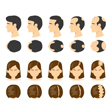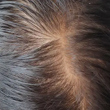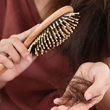Myths Surrounding Minoxidil
Introduction1, 2, 3
In the contemporary trichology and hair care fields, minoxidil has become almost synonymous with AGA treatment, being prescribed by dermatologists for over 30 years. Despite its widespread usage, it is not yet fully understood how minoxidil actually works. Due to this, there are several fears, hair fall myths, and misconceptions--often clashing ones--surrounding minoxidil. While some fear that minoxidil may worsen their hair fall, others wrongly believe that it can reverse complete baldness!
Let us debunk seven common hair fall myths about minoxidil and get the facts right.

Seven Common Myths about Minoxidil Debunked1,2,3
If you are about to start your minoxidil treatment, you might feel overwhelmed by all the information available online. We make it easier for you to separate the facts from the myths.
Myth 1: Minoxidil can’t be used by women 1,2
A very common hair fall myth surrounding minoxidil is that women can’t use it. The medical fraternity first approved minoxidil for treating AGA in men in 2006, which likely gave rise to the myth that it is not suitable for women. However, more recently, in 2014, Health Canada and the FDA approved topical minoxidil as a credible treatment for female pattern hair loss (FPHL). The Central Drugs Standard Control Organization (CDSCO) in India approved the use of minoxidil to treat AGA in women in 2021. Significant positive changes in hair thickness have been observed in women using topical minoxidil in various scientific studies.
Myth 2: Minoxidil can reverse complete baldness 3
While there is no doubt that minoxidil can help stop excessive hair loss and even promote hair regrowth in certain cases of AGA, the claim that it can help reverse complete baldness in either men or women is baseless. If you are experiencing excessive hair loss due to AGA, it is better to contact your dermatologist at the earliest.
Myth 3: Minoxidil makes hair loss worse 3
Minoxidil tends to affect the anagen and telogen phases of hair growth. Because of this, some people may experience increased shedding in the first few weeks of using the medication while their hair cycle adjusts to this change. However, this shedding is likely to stabilize over some time with regular use. Most people start noticing the thickening of their hair within a few months of regularly using minoxidil for AGA, and you can expect the same results if you follow your dermatologist’s instructions. Just keep in mind that stopping your minoxidil treatment may cause your hair to fall out again.
Myth 4: Minoxidil has zero side effects 3
Some unverified online sources might mention that minoxidil has no side effects. This is not true. While minoxidil is generally considered safe for topical application for most people, it does have a few side effects. Skin itchiness, rashes, dryness, flakiness, headaches, and facial hypertrichosis are some possible side effects of using minoxidil. However, not every person who uses minoxidil experiences these side effects, and in most cases where they do occur, the side effects are mild and manageable.
Myth 5: Minoxidil is available over the counter 2
Another common misconception about minoxidil is that it is available over the counter at most medical stores. In India, minoxidil is a prescription medication that you can’t purchase over the counter. If you think minoxidil could be a probable solution for your hair fall issues, you first need to discuss it with your dermatologist, who may prescribe it if they deem it appropriate. Only a qualified medical practitioner can prescribe you any medication containing minoxidil only for the treatment of AGA.

Myth 6: Minoxidil doesn’t affect your hair color or structure 3
Before starting their minoxidil treatment, many people believe that their hair color and structure will remain intact throughout the treatment. However, this is a hair fall myth connected to the medication. Anecdotal evidence suggests that some users of minoxidil experience a change in the original color and structure of their hair. Your hair is likely to become darker in color and curlier, coarser, and drier in texture following your minoxidil treatment.
Myth 7: Minoxidil is bad for your skin 3
A minoxidil myth that has been making the rounds on the internet is that minoxidil is bad for your skin. While it is true that oral minoxidil may cause skin irritation or rashes in some users, topical minoxidil doesn’t affect the overall quality of your skin in the long run. There is no reason for concern if you have normal and otherwise healthy skin. People with extra-sensitive skin or skin diseases should first discuss their skin issues with their dermatologist before proceeding with the minoxidil treatment.
Conclusion
Minoxidil is a scientifically-backed, widely prescribed medication for ADA in both men and women. However, because of multiple ways in which Minoxidil works is postulated, it has given rise to numerous baseless myths. Trust only credible sources of information when it comes to debunking hair fall myths.
Maintaining a healthy and stress-free lifestyle along with a nutritious diet is also important for optimal hair care. Visit your dermatologist for any hair fall-related complaints to get an optimal diagnosis and management plan.
Disclaimer: Minoxidil is a prescription-only drug. It is to be taken only after a dermatologist’s assessment and prescription. Please consult your dermatologist for further guidance.
Myth Busters HairFall

Androgenetic Alopecia - Everything You Need To Know
Have you been experiencing excessive hair fall over a prolonged period of time? It could be an early sign of androgenetic alopecia. It is a hair loss disorder common in both genders and can lead to progressive thinning and even baldness in some patients if not caught and treated early.

How To Make Hair Grow Faster For Men
A head full of healthy hair is a matter of confidence. Hair has its own mechanism of growing and shedding, and it is when this mechanism is thrown off that growth is hindered. Especially in the case of males, hair growth faces a lot of hiccups that can easily be managed.

Female Pattern Baldness - Causes & Treatments
Have you suddenly noticed an increase in the number of hair strands on your pillow in the morning? Or is your ponytail getting thinner by day? Well, you might be suffering from female pattern baldness. While that does sound scary, identifying it early on is key to treating this condition effectively. So keep reading to know what this is, how you can identify it, and most importantly, what treatments you can avail of to get your beautiful lustrous hair back.

What Are The Reasons For Hairfall?
Almost everyone experiences some amount of hair thinning over the years. Shedding around 50 to 100 single strands of hair per day is considered normal. However, losing more than 150 strands a day, experiencing sudden thinning, or developing circular bald patches on your scalp are reasons for concern. Hair loss occurs when new hair doesn’t grow fast enough to replace the amount of hair you lose daily. Hair can fall due to various reasons, with hereditary hair loss and poor nutrition being the most common hair fall reasons.

Expert Approved Tips For Hair Growth
What can be more debilitating than seeing hundreds of hair strands shedding from your scalp every time you brush your hair? Also, excessive molting occurs during seasonal changes that can be very stressful for you. Although it’s okay to lose between 50-100 strands every day, according to the American Academy of Dermatology, the problem occurs when you start shedding more than normal. But that doesn’t mean you have to feel helpless as there are ways to grow your hair back. Even if you are coping with baldness or alopecia, certain hair growth tips from dermatologists can come to your rescue. Read on to discover how these tips can be your savior when abnormal hair fall problems are in sight.
Trending Videos
+ 3 Sources
'LMRC - GGI-CO-A2-DMA-300001252-300001252-WM-L21-704'
© 2021 Dr. Reddy’s Laboratories Ltd. All rights reserved.